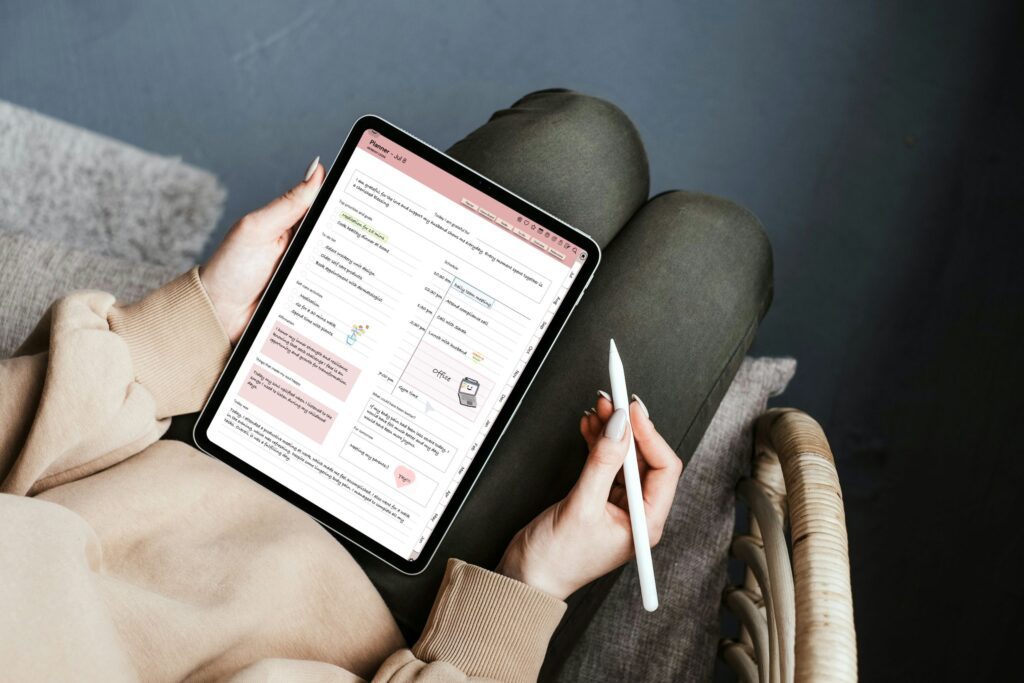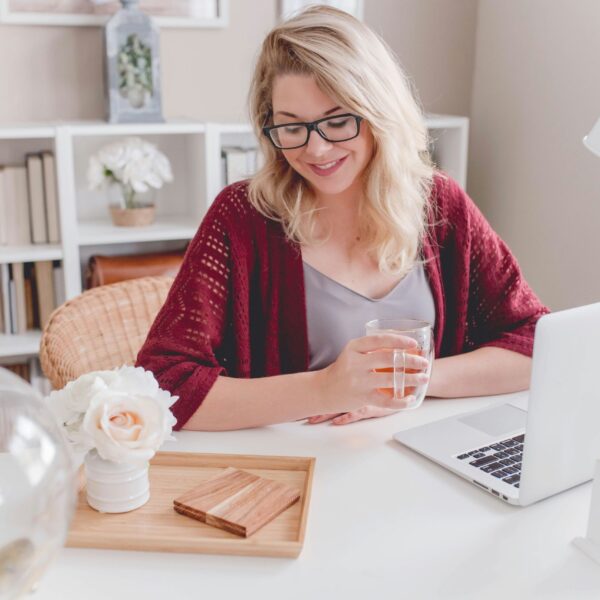When you wake up in the morning, what’s the first thing you do?
Most probably, without even thinking, you reach for your phone. It’s such an automatic action that it doesn’t even feel like a choice, it just happens.
It’s not just you, it happens with most of us.
Before we’ve even gotten out of bed, we’re scrolling through social media or checking messages, almost as if our hands have a mind of their own.
This is just one example of the many habitual patterns that shape our daily lives. We all have these routines, and they’re so ingrained in us that we often don’t even notice them.
Think about your own morning routine. After reaching for your phone, maybe you head to the bathroom to brush your teeth, then make a cup of coffee, and perhaps grab a quick bite to eat.
All of this likely happens without much conscious thought. It’s as if we’re on autopilot, moving from one task to the next without really being present.
These habitual patterns are like well-worn paths in our minds. We’ve traveled them so many times that they’ve become the default way we operate.
Over time, they become second nature, so familiar and comfortable that we hardly question them. They provide a sense of stability and predictability which is very comforting.
But because they’re so automatic, we rarely stop to consider whether these patterns are actually serving us well.
On top of all this, we now live in a fast-paced and technologically advanced world where our minds are often preoccupied with what needs to be done next.
Because of this, we’re always disconnected from the here and now.

This is where the concept of mindful living comes in. Mindful living is about breaking free from these automatic routines and bringing more awareness into our everyday actions.
But mindful living is not just about changing our mindset, it is about recognizing the habitual patterns that dictate our lives and questioning whether they truly serve us well or not.
These patterns that seem familiar and comforting often keep us stuck in routines that may not align with our true values and goals.
That’s why is it important to become aware of these unconscious habits so we can start making intentional choices that better reflect who we are and what we want out of life.
Welcome to this blog where we’ll explore the idea of habitual patterns and how they shape our daily experiences. We’ll guide you through five key tools that can support and improve your mindful living journey.
Let’s get started by understanding what mindful living is.
Table of Contents
What Does Mindful Living Mean?
As we just discussed, right from the moment we wake up, there’s a habitual pattern at work.
It’s something we do without thinking, a routine that’s been ingrained in us over time. But it’s not just our daily routines that are shaped by habitual patterns. The same goes for many other aspects of our lives.
Our emotional reactions, thought processes, and even the way we interact with others are often driven by these unconscious habits.
For example, you might automatically feel defensive when someone criticizes you, or you might find yourself thinking negatively about a situation without realizing it.
These are patterns of behavior and thinking that have become second nature to us which are often based on past experiences or repeated behaviors.
Even our coping mechanisms and the way we hold ourselves physically are influenced by these unconscious habits.
When we’re stressed, we might automatically reach for a snack, turn on the TV, or do other activities that distract us from our discomfort.
These actions may provide temporary relief but they don’t address the underlying issues.
Mindful living is about understanding these patterns and how they influence our lives.
It’s about paying attention to what we’re doing, thinking, and feeling in the moment, rather than going through life on autopilot.
By becoming more mindful, we can begin to recognize these habitual patterns for what they are and start making more intentional choices that align with our true values and goals.
5 Right Tools for Living Mindfully
Let’s now take a look at how we can bring more mindfulness into our routines.
While understanding these patterns is very important, changing them would require the right tools. And just like any other practice, having the right support and tools will make all the difference.
Here are 5 tools that can guide and support you as you work to bring more mindfulness into your life.
1. Meditation
Meditation is the foundation of mindful living because it is a practice that teaches you how to control your thoughts and stay in the present moment.
It teaches you how to observe your thoughts and emotions without judgment and being overwhelmed by them.
Benefits of Meditation in Mindful Living
There are so many benefits of meditation that help in mindful living.
First and foremost, it is very helpful in reducing stress and anxiety by helping you learn how to calm your mind and focus on the present. Instead of worrying about the past or future, it teaches you how to focus on the here and now.
Additionally, meditation improves your ability to concentrate and stay focused which is very valuable in today’s fast-paced world where there are so many distractions.
This increased focus is not just limited to your meditation sessions, it also helps you stay present in everyday activities.
Over time and with regular practice, you become more aware of your habitual patterns and are able to break free from them which will help you lead a more mindful and intentional life.
How Do I Start Meditating if I Am a Beginner?
If you’re new to meditation, starting the practice might seem a bit daunting, but it’s simpler than you might think.
Start by setting aside just a few minutes each day to meditate. Find a quiet space where you won’t be disturbed, sit comfortably, and close your eyes.
Try to focus on your breath and feel the air coming and going in and out of your nostrils. Notice your chest rise and fall.
If your mind starts to think about different things, which it will because that’s the nature of the human mind, be gentle and try to bring your focus back.
There are also various types of meditation to explore, such as guided meditation, where a voice leads you through the process, or mindfulness meditation, where you focus on being present in the moment.
The most important thing for beginners is consistency.
Even if you meditate for just 5 minutes a day, it will have a very positive impact if you do it regularly. As you become more comfortable with your practice, you can gradually increase the time of your sessions.
What to Think About When Meditating?
One of the common misconceptions about meditation is that you need to completely clear your mind of all thoughts.
In reality, meditation isn’t about stopping your thoughts but rather observing them without getting caught up in them.
When you meditate, your focus should be on your breath, a mantra, or even a simple object like a candle flame. The goal is to bring your attention back to this point of focus whenever your mind starts to wander.
You might also practice mindfulness meditation, where you observe whatever comes to mind without judgment. This could be thoughts, emotions, or physical sensations.
The key is not to engage with these thoughts but to acknowledge them and let them pass like clouds drifting across the sky.
By doing this, you train your mind to stay present and avoid getting lost in your thoughts.
What Are the 5 Stages of Meditation?
People often ask about the different stages of meditation but there isn’t any universally agreed-upon number of stages in meditation.
Different traditions and teachings have different number of stages based on their specific practices and goals.
Let’s take a look at a common framework that has the following five stages:
- Concentration: In the first stage, the focus is on developing concentration.
It is about consistently bringing your mind back to your point of focus, such as your breath or a mantra.
It’s normal for your mind to wander frequently at this stage, but with practice, your ability to concentrate will improve.
- Awareness of Distraction: As your concentration strengthens, you become more aware of the distractions that pull your mind away.
In this stage, the key is to recognize when your mind has wandered and gently guide it back without frustration.
- Sustained Attention: In the third stage, your ability to maintain attention on your chosen focus improves, leading to longer periods of sustained concentration.
Distractions become less frequent and you begin to experience deeper levels of focus.
- Deepening of Mindfulness: As you continue to practice, your mindfulness deepens. You become more aware of the subtle workings of your mind.
- Absorption: In the final stage, you enter a state of deep absorption, where your focus is so strong that the outside world fades away.
You feel fully immersed in the present moment during this stage of peace and stillness.
What Happens When You Meditate Every Day?
As we discussed above, when you meditate regularly, you’ll see that there is significant improvement in terms of reduced stress and anxiety. This is because regular meditation helps calm the nervous system.
It also improves your emotional resilience which will help you handle challenges with calmness and composure.
You’ll see that you’re less reactive to stressful situations and more capable of responding thoughtfully rather than impulsively.
You’ll also have a greater sense of self-awareness because you become more attuned to your thoughts and emotions.
2. Journaling
Another powerful tool for mindful living is journaling, which is a simple practice of putting your thoughts and feelings on a piece of paper.
This simple act of writing gives you a chance to slow down and think about what’s going on inside and around you.
It gives you a space for self-reflection so you can understand yourself and your life on a deeper level.
When you journal, you can step back and look at your thoughts and feelings without judging them.
It’s a way to process what you’re experiencing and get clear on things that might feel overwhelming. Writing things down helps you spot patterns in your thoughts and actions, which can guide you to make more mindful choices.
Journaling can also help you feel grounded. It offers a moment to pause, take a breath, and focus on the present.
Whether you’re writing about your day, your goals, or just your feelings, journaling brings your attention to the here and now. It’s a chance to be fully present with yourself, away from the noise of the outside world.
We’ve seen how powerful journaling can be in our own lives.
It’s not just about writing things down, it’s about staying connected to the things that truly matter and making sure our goals stay on track.
Journaling has become a part of our daily routine, and it helps us stay grounded and focused every day.
Because of the difference it’s made for us, we wanted to create something that could help others too on their journey toward mindfulness and self-awareness.
That’s why we came up with the Mindful Living Digital Planner. This planner isn’t just about organizing your day, it’s a tool designed to bring mindfulness into your everyday life.
We wanted to make it easy for you to keep up with mindfulness practices like journaling, gratitude, affirmations, and self-care.
The planner helps you stay organized while also giving you a space to reflect on your thoughts and progress. Whether you’re just starting out or have been journaling for a while, we believe this planner can help you along your journey.
So, if you’re looking for a way to bring more mindfulness into your daily routine while keeping everything in order, we hope you’ll check out our Mindful Living Digital Planner.
It’s been a game-changer for us, and we think it could make a difference for you too.

Related blogs on journaling:
- What Is Journaling and What Are Its Benefits?
- What Are The Different Types of Journaling
- 5 Simple Steps to Start Journaling for Mental Health
- How and Why You Should Start a Gratitude Journal
- How to Journal for Personal Growth and Self-improvement
- What Is a Manifestation Journal and How to Journal for Manifestation
- How to Start a Health and Wellness Journal
- How Can Journaling Boost Your Productivity
- How to Journal for Overthinking
- What Is a Morning Journal and How to Journal in the Morning?
- Journaling vs. Keeping a Diary: What’s the Difference?
3. Mindful Breathing
Mindful breathing is one of the simplest yet most effective tools for living mindfully.
It’s something we all do every day, but when we pay attention to our breath, it can become a powerful way to bring ourselves back to the present moment.
Think about how often we go through our day without really noticing our breath. It’s just there in the background, keeping us alive, but rarely do we take a moment to focus on it.
But when we do, something shifts. Mindful breathing is about tuning into your breath, feeling the rise and fall of your chest, and letting it anchor you to the here and now.
When you practice mindful breathing, you’re giving yourself a break from the rush of thoughts and worries that often take over our minds. It’s a way to slow down and reconnect with yourself, even if just for a few moments.
One of the great things about mindful breathing is that you can do it anytime, anywhere.
Whether you’re sitting at your desk, standing in line, or lying in bed, you can take a few deep breaths and feel yourself become more present. All you would need is your breath and your attention.
Over time, as mindful breathing becomes a regular part of your day, you’ll notice that it is easier for you to stay calm and centered, even in stressful situations.
It’s a small practice with big benefits, and it’s a tool that’s always available to you, no matter where you are or what you’re doing.
4. Gratitude
Another important tool for mindful living is Gratitude, one that can truly transform the way you see the world.
Practicing gratitude is about taking the time to appreciate the good things in your life, no matter how small they might seem.
When you practice gratitude, you shift your focus from what’s lacking or going wrong to what’s already present and going right.
We live in a fast-paced and hectic world where we often forget to acknowledge the positive aspects of our day.
We might overlook the warmth of the sun on our face, the comfort of a good meal, or the simple joy of a smile from a stranger.
But when we make a habit of noticing and appreciating these moments, we start to see that there’s so much to be thankful for, even on the most challenging days.
Gratitude doesn’t mean ignoring difficulties or pretending everything is perfect. Instead, it’s about recognizing that even in tough times, there are things worth appreciating.
This practice also helps us build resilience, which makes it easier for us to cope with life’s ups and downs with a positive attitude.
One of the best ways to cultivate gratitude is through journaling. Our Mindful Living Digital Planner makes this easy with daily prompts designed to help you reflect on the things you’re grateful for each day.
Take a few minutes every day to write down three things you’re thankful for. They don’t have to be big or life-changing; they can be as simple as a delicious cup of coffee, a kind word from a friend, or a moment of peace during a busy day.
With time, this practice will help you develop a more positive mindset, as it will train your mind to look for the good in every situation, allowing you to develop a more positive outlook in life.
The beauty of gratitude is that it’s accessible to everyone. You don’t need any special skills or resources, just a willingness to pause, reflect, and appreciate.
And as you practice gratitude more regularly, you might find that it not only makes you feel happier but also deepens your connections with others and the world around you.
Here are some blogs on gratitude to help you understand this concept in detail:
- What Is Gratitude And Why Is It So Important?
- 5 Simple Ways To Practice Gratitude Everyday
- Finding Silver Linings in Challenging Situations Through Gratitude
5. A Practical Mindset
Having a practical mindset is key to living mindfully because it helps us get through life with more ease and peace.
Life is full of surprises, twists, and challenges that can sometimes make us feel frustrated and stressed.
But by developing a practical mindset, we can handle things better, reduce unnecessary stress, and find contentment in the present moment.
One of the key aspects of a practical mindset is learning to let go of unrealistic expectations. We all have times when we imagine a perfect day or expect things to go exactly as planned.
But the truth is, life doesn’t always follow our plans. Holding onto these expectations can disappoint us.
A practical mindset means understanding that while it’s okay to have hopes and dreams, holding on too tightly to them can cause unnecessary pain.
Instead, we learn to accept life as it comes, imperfect, unpredictable, and often out of our control.
Another important piece of this mindset is accepting people and situations as they are. When we stop trying to change others or fight against what’s happening, we make room for peace.
This doesn’t mean we just give up, but rather that we approach life with a realistic and flexible attitude.
Whether it’s a tough relationship, a challenging job, or a personal struggle, accepting what is lets us focus on what we can actually do, instead of being stuck wishing things were different.
Letting go of expectations goes hand in hand with this acceptance.
Expectations often lead to disappointment, whether it’s expecting a project to go smoothly, assuming others will act a certain way, or believing life should always be easy.
When we let go of these expectations, we free ourselves from the rollercoaster of hope and letdown that helps us experience life with less stress.
It’s about being open to whatever comes without being too attached to how things should turn out.
Part of having a practical mindset is also getting comfortable with discomfort.
We live in a world that values comfort, but growth often happens when we step out of our comfort zones.
Whether we’re starting something new, embracing healthier habits, or making tough decisions, discomfort usually plays a role in the process.
When we gradually increase our tolerance for discomfort, we build resilience and open ourselves up to new possibilities.
A practical mindset recognizes that discomfort isn’t something to avoid but a natural part of life’s journey.
Lastly, a practical mindset teaches us to let go of the idea that we can control everything. Many of us like to think we have control over our lives and we try to carefully plan every detail and strive to keep everything in order.
But life is unpredictable, and no amount of planning can account for everything. When we learn to go with the flow and let go of the need to control everything, we reduce stress and find a deeper sense of peace.
It’s about trusting that we can handle whatever comes our way, even when things don’t go as planned.
In short, a practical mindset is about facing life’s realities with grace and wisdom. It’s about finding a balance between hope and acceptance, between planning and being flexible.
Developing a practical mindset is the key to living more mindfully, with less stress and more joy.
How Do You Practice Mindful Living?
One of the best and simplest ways to start practicing mindful living is by incorporating small and mindful habits into your everyday routine.
This could be taking a few deep breaths before starting your day, focusing on the sensations as you walk, or dedicating a few minutes to reflect on what you’re grateful for.
Over time, these small moments of mindfulness will add up and make you more mindful in your everyday life.
Another key aspect of mindful living is learning to respond to life’s challenges with a practical mindset.
As we just discussed, having a practical mindset means accepting things as they are, letting go of the need to control everything, and embracing the unpredictability of life with grace.
Mindful living isn’t about perfection, it’s about progress. It’s about making a conscious effort to be more present, more aware, and more at peace with where you are right now.
Wrapping Up – How to Be Mindful All Day?
Hopefully, these tools will help you live a life that is more mindful and intentional.
Rather than being victims of the habitual patterns that govern most of your day, you’ll be able to make conscious choices that align with your values and goals
This shift will also reduce the stress and anxiety in your everyday life.
It’s time for you to start living mindfully. There’s a beautiful world out there, full of moments waiting for you to truly experience.
As you take steps toward this practice, you’ll notice your mind often wanders.
It’s natural, and it’ll happen many times throughout the day. But each time you catch yourself drifting, gently bring your focus back to the present.
With time and practice, you’ll become more mindful, and those moments of drifting will happen less and less.
If you’re already practicing mindfulness in your daily life, do let us know of your experiences so we and the wider community can learn from them. Namaste!
Related Blogs – How to Practice Mindful Living?
- What Is Mindfulness And Why Mindfulness Is A Superpower
- What Is Mindful Living And How To Live Mindfully
- What Is Mindfulness Meditation And How To Do It
- How To Practice Mindfulness In Your Daily Life
- 7 Healthy Habits to Live a Mindful Life
FAQs
Is Mindfulness a Tool?
Yes, mindfulness is a tool and a very powerful one.
It helps you stay present and fully engage with whatever you’re doing. In the blog, we discussed different tools for mindful living, like meditation and journaling, which help you practice mindfulness in your everyday life.
What Is Mindfulness in Psychology Tools?
In psychology, mindfulness is a key tool used to help people focus on the present moment, manage stress, and reduce anxiety.
It is about paying attention to your thoughts and feelings without getting swept up in them. This supports better mental health and emotional balance as we discussed in this blog.







Leave a Reply